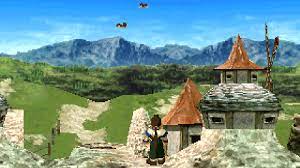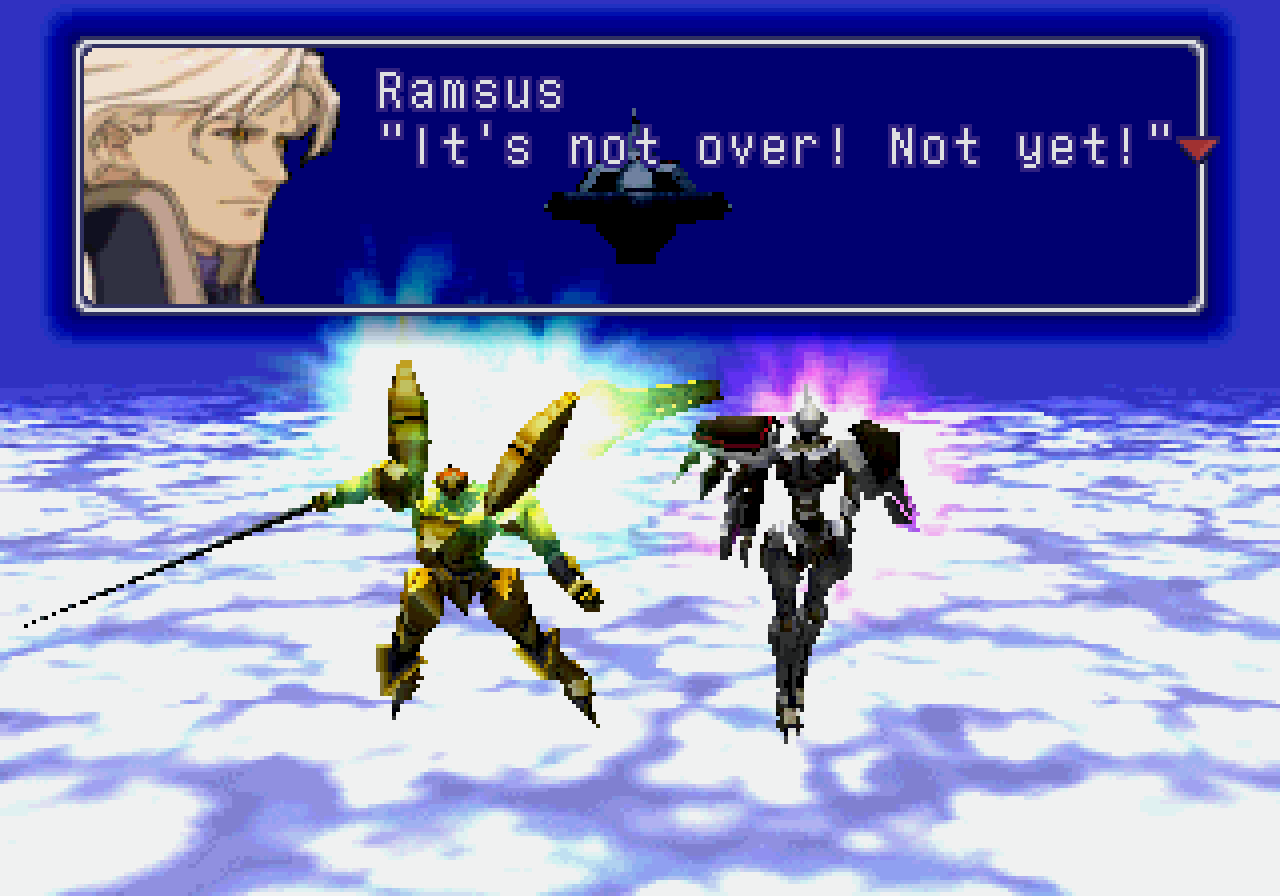Xenogears, much has been written about the game on this site, and on our FB page. Twenty-three years later, it remains a fan favorite. Some would even argue that it was the greatest JRPG on the original PlayStation. Are these fans, right? Well, even if they are not, they are certainly onto something.
Xenogears is the most ambitious JRPG that I have ever played, and its flaws, for the most part, are a direct result of such ambitions.
The Greatest JRPG Story Ever Told…Aside From a Rushed Disc 2

The one thing that can’t be debated is that Xenogears’ storyline is a complex beast. Truly, it is the most ambitious one that has ever been written in the genre. Created, directed and written by Tetsuya Takahashi, and his wife, Kaori Tanaka, Xenogears was initially pitched as a script for Final Fantasy VII.
Squaresoft turned it down, deeming it ‘too dark’ for a Final Fantasy game (even though Final Fantasy VII was dark as well). Perhaps, Square got cold feet because Xenogears took a lot of shots at organized religion, mainly Christianity, which could have affected the game’s marketability on the predominantly Christian west.
Final Fantasy (as opposed to Dragon Quest) had found some success on the U.S. and Square probably feared that a game dealing with such ‘controversial’ topics would hurt the brand in said market.
Either way, the game got green lighted as its own separate project though not without some now known caveats.
Square gave Takahashi a two-year deadline. The director had to make do with a depleted budget in order to create the infamous Disc 2. Squaresoft wanted only Disc 1 to be released (as the deadline approached), but Takahashi refused to deliver an incomplete story. Thus, he was allowed to deliver a rushed Disc 2. Considering that Square abandoned the IP afterwards, without the rushed Disc 2, we would have never received a conclusion the game’s storyline.
Under these circumstances, I believe Takahashi was in the right, and we are actually lucky that we got Disc 2 at all. We must remember that at the time, Square’s full focus, and budget was aimed at its Final Fantasy brand (namely Final Fantasy VIII). It is likely that Squaresoft did not have much faith in Xenogears. The Japanese publisher almost didn’t release the game on the US thanks to the company’s fear of the game’s ‘sensitive’ religious content.
Square was Wary of Xenogears’ Religious Overtones
The 1990s, in terms of creative freedom, was largely a conservative decade for gaming. Many games that came from Japan featured edits, and censorships in order to avoid controversies on Western soil.
Takahashi had been heavily influenced by ‘Freudian’ (and Nietzsche) theory, and Xenogears was a canvas for him to express his take on said theories.
“Killing god” (a sentient supercomputer in the game) was one of the game’s underlying themes, and end goal. Abel, Cain, ‘Alpha and Omega’ are biblical names, and concepts that are freely utilized in the game’s plot line.
Truly, Xenogears threaded dangerous (controversial) ground based on the ideas that it promoted. The translators had to change some of the more offensive material, but the game that we got remained, for the most part, true to its intended message.
Xenogears is a game that has to be played a few times, and with a note pad, in order to grasp everything that it has to offer story wise. That is the game’s greatest strength. Consequently, it might have been the reason why it didn’t achieve the mainstream success that other contemporary titles in the era attained.
I had a college classmate that once said while chuckling, “I have beaten Xenogears twice. I still don’t know what the plot is about.”
The wonderful Anime Cutscenes, the amazing music, and the emotional moments in a love story (between Fei and Elly) that far surpassed anything that Square’s ‘A-Team’ was able to conjure between Squall and Rinoa (Final Fantasy VIII), or Cloud, Aerith and Tifa (Final Fantasy VII) remain engrained in my memory.
Xenogears, to this day, embodies the definition of ‘Epic’, and I would wholeheartedly recommend any JRPG fan today to play it, even 23 years later. The story, in my opinion, remains the genre’s best.
Some of Mitsuda’s Best Work Ever
Yasunori Mitsuda is a legend. Apart from Nobuo Uematsu, Mitsuda is probably the greatest JRPG music composer around. Don’t believe me? Listen to Chrono Trigger, and Cross…musical nirvana. The game’s OST is available in two discs, and there was a 2011 orchestrated version of the soundtrack, arranged by Mitsuda himself.
I consider the Trigger, Cross, Xenogears trifecta to be Mitsuda’s absolute music composing peak. Thankfully, he remains involved and invested in the Xeno series with contributions to the Xenoblade Series’ soundtracks.
Beautiful Graphics, and a Great Battle System
Xenogears was intended to be a full a 3-D game, but the PS1’s technical limitations kept it from being one. Instead, we received a mixture of 2-D sprites for characters and ¾ top view camera with fully routable 3-D environments.
In my opinion, Xenogears is the best-looking game that utilizes this visual format, surpassing both Grandia and Breath of Fire IV.
Battles are turn based (ATB). The combat utilizes a combo system that is both deep and intuitive, even though grinding was necessary for ultimate success. During the Gear battles, prime equipment, and fuel conservation (as opposed to AP) were the keys to winning. Because you can’t level up the Gears (aside from equipment), strategy was a key part getting through these battles.
The game is tough, but even though this is an 80-hour long adventure, grinding wasn’t a huge issue for me. It was actually fun to grind, and that’s something that I don’t usually say of JRPGs, but I didn’t have a problem with the random battling in Xenogears.
Xenogear’s Legacy

The game ends with an “Episode V” line in its credits. This implied that Xenogears was episode V in a series that had, at least, five previous episodes planned. Talk about ambitious. Instead, we received the PlayStation 2 (Namco published) Xenosaga trilogy.
The trilogy wasn’t bad, and at times, it did feel like Takahashi (and his company Monolith Soft) was trying to ‘reboot’ Xenogears with the spiritual sequels in Xenosaga. However, less than expected sales, forced Namco to cut Xenosaga’s planned 6 episodes in half to a grand total of three. The series underperformed commercially to the extent that each subsequent episode sold less than the last.
Clearly, Xenogears’ fans never warmed up to Xenosaga and its episodic nature. Xenosaga’s commercial failure wouldn’t be the end for Monolith, and the Xeno franchise. Takahashi would resurface writing for the Xeno series in the more commercial, and far more accessible, Nintendo published Xenoblade Chronicles Series.
Monolith Soft’s latest effort, Xenoblade Chronicles 2, has sold over 2 million copies, ensuring that the series will live on for the foreseeable future.
While the current Xeno games are not as heavy, or a deep in terms of storytelling, as Xenogears was in 1998, Takahashi successfully spanned a long running franchise. His vision of Mechs fighting in a wondrous Sci-Fi world, with religious and existentialist overtones has continued to thrive beyond the original 1998 classic.
My Final Word
As much as I enjoyed Xenoblade Chronicles on the Wii (which is Monolith’s highest rated game), Xenogears was just special. I don’t think the current gameplay/storytelling format in which the Xenoblade Chronicle Series exists will produce another game of the scope, and grand ambitions that fueled the original.
Commercially speaking, Xenoblade is more accessible than Xenogears ever was. However, that does not necessarily make the newer entries better games, it just makes them safer investments (for Nintendo).
I still believe that Xenogears is the best Xeno game in existence and it will take an extraordinary game in the series to change my mind.
Agree with the author? Couldn’t disagree more and are frothing at the mouth to tell him? Leave a comment here, on Facebook or send an email and make sure to follow Never Ending Realm on Facebook, Twitter, and YouTube!
